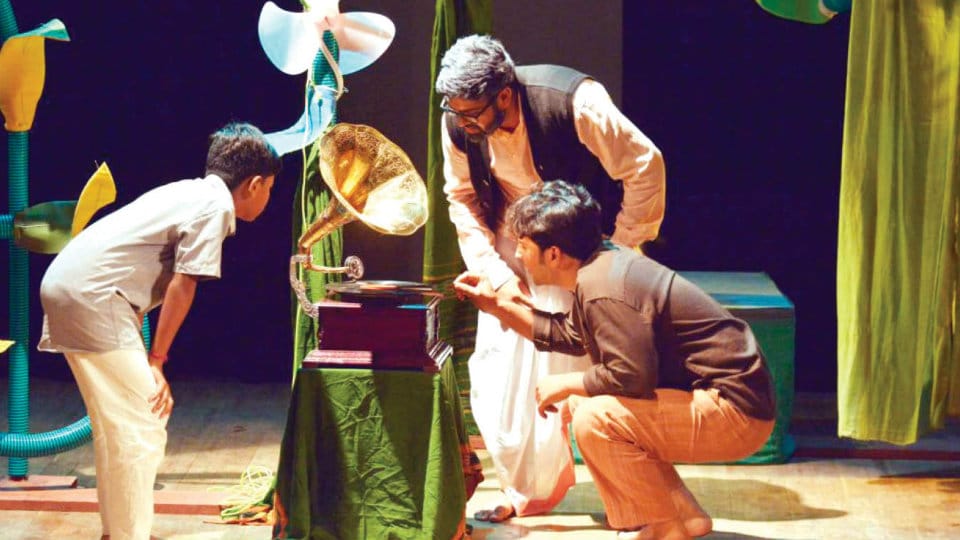Four months ago, one of my friends from Pune sent me a play list of old Hindi songs. Born and brought up in Mysuru, training in Karnatak music, the only ones I knew were the ones Bombay Jayashri sang in an innovative concert years ago. My senses were not yet woken to the music of yesteryear cinema. This play list was, in all ways, an initiation. These songs seemed like fresh air, sweeping me off my feet with a sedate pace, rich essence in simple lyrics and soft tunes.
Two days later, I watched Parshva Sangeetha. Life in that era — the era of those Hindi songs — seemed no different from ours, in terms of the possibilities of human emotion (maybe, that’s also why the play works), but what is significantly different is the influence film music yields on the daily affairs of the common folk. Parshva Sangeetha captures that.
Music here is not just another ingredient. It’s a character. An Ajji beside me in the theatre said that the gramophone had been, in fact, a character in their house, serving as a chaperone, evoking emotions at dawn, and relieving them as dusk. In the play, she saw its reflection.
The gramophone — illustratively occupying the centre-stage — represents different things to different characters: an extension of notorious modernity for the Ajja (Manjunath Shastri), a torch of rebellion for the Chikkappa (Poornachandra), and a source of rapture for the little Seenu (Sukhadev). Through the device, Saigal, Mohd. Rafi, Kishore Kumar, lata Mangeshkar sing apt tunes to the events on stage. It’s a two-way process: if Pyaar Hua Ikraar Hua supports the romance of Chikkappa and Kaku, a sentimental scene during Kaku’s ailment brings BaharoPhool Barsao alive on stage.
There is a formulaic touch of melodrama: the dance sequence(s), straight from the cinema screens. Usually, dance in the middle of drama — especially in a realistic play such as this — dissolves the mood of the moment. In Parshva Sangeetha, though, the dance acts as a metaphor for the supremacy of cinema in daily life: how hairstyles changed with heroes, how necklines changed with heroines, how film songs became invocations, how film posters became book covers, and even how cigarettes made their way into young men’s health. In a time when theatre and cinema are popularly seen as antagonistic to each other, it’s refreshing to watch a play — with colourful stage design (H.K. Dwarkanath) and retro costumes (K.R. Nandini) — paying tribute to cinema and music and dance, and most importantly, to literature.
This production by Rangavalli, is based on the sulalita prabandhas of Srinivasa Vaidya. To render novels and stories theatrically is itself a daunting task. What can we say of personal essays? They have an oral-written quality that’s hard to translate visually. And initially, it does feel so in Parshva Sangeetha.
It begins with an old Srinivasa (Murali Gundanna) recollecting his childhood (and the power of cinema) after his daughter makes a spectacle of protest in the grip of die-hard fan-ism. This ten-minute introduction and flashback is presented with only monologues, and takes time to get to the theatrical track.
B.P. Arun’s script takes off only with the arrival of Chikkappa. He is truly a chikkappa (or an anna or a mava in the house, a true inspiration to impressionable kids wanting to break the confines of conservative thought), the only person who can look eye to eye with Ajja.
The entire play is built around the life of this chikkappa: his college, his love, his anger, his wit, his marriage, and his cassette records. Poornachandra essays his role with reminiscences of heroes from his time, behind whose style and pomp was a softness (amiss is macho performances today). Interestingly, his proposal scene to Kaku sent the senior citizens in the theatre to red blushes, probably reminding them of their colleges, their bicycles, and nephews and nieces acting as passenger pigeons. The pigeon here is Seenu; and Sukhadev aces this role with innocent emotions and perfect comic timing! The other star is Ajja. Although he’s steamed up in every scene, he is adored because he’s the familiar grey-haired head of the family: snappy but vulnerable.
While the music and the dance are all the blossoms of people’s imagination in their lives, the play makes sure it sticks to reality with a harrowing end. And the audience did shed tears, like they shared laughter before. Theatre, Parshva Sangeetha tells us, is a community activity: built by actors and crew, sharing their time and energy; participated in groups, sharing thoughts and emotions.
Parshva Sangeetha reminds us of two other things: one, the eternal sway of old Hindi songs — or old film songs, for that matter, with their aesthetic literary arms and positive melodic embrace. And two, of the excellence of a well-directed play. Neither the length of the play, nor the occasional presence of the ‘essay(s)’, distracts the able vision of Prashanth Hiremath, a Rangayana thespian: to stage a warm story warmly.
The play is back on stage on Jan.6, in Kiru Rangamandira (Mini Theatre) in Kalamandira premises, at 7 pm. Once in a while, amidst the many thought-provoking plays that carry powerful messages, we need a play that simply entertains. This is one.
—Vighnesh Hampapura
Follow Star of Mysore on Instagram www.instagram.com/starofmysore








Recent Comments